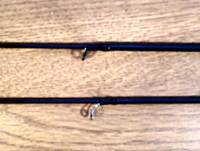This is a very common occurrence; the best way of avoiding it is always to carry your rod/rods butt first! A great tip but a bit late for Nev. So here we go. All built in quivertips are ‘spliced’ into the rod. This simply means that the quivertip section is slid inside the rod tip section then whipped in place. The fine tips on a lot of stickfloat match rods are made in the same way so this repair will cover those as well. The first thing to do is locate where the splice is. This will normally be a slight step-down covered with a whipping. If you cannot easily find it the rod builder may have combined the splice whipping with a rod ring whipping. Once located remove the whipping carefully using a sharp Stanley knife. Take care not to damage the blank. Once removed, also remove any other rings on the broken section. Good rod builders do not glue the tip in, relying on an interference fit and the whipping to keep it in place. Due to this you may be able to simply push the broken tip back inside the blank and remove it (some rods have a small blanking piece inserted into the blank at the base, this will obviously need to be removed). If you are unfortunate and the tip has been glued into place you have the following alternatives. Warm up the area of the splice with a hair dryer and try pushing the broken section in whilst gently twisting. Go careful here as too much twisting can damage the blank. If this fails then you will have to cut the blank. This is best done with a triangular file. Take off 2ins and if there is still some of the broken tip left inside keep cutting back in
|
Welcome!Log into your account














